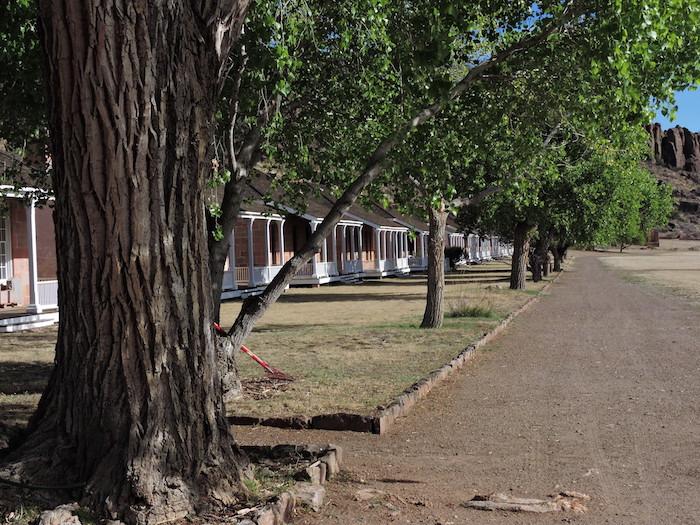
Officer's Row at Fort Davis National Historic Site was comfy quarters compared with many other posts in the Army/Lee Dalton
Every few minutes, a bugle call sounded across the empty parade ground at Fort Davis National Historic Site in the rocky hills of west Texas. Every time I heard one, I expected to see John Wayne riding in front of a long column of blue-clad cavalry troopers galloping to rescue me from Apache or Comanche warriors. The breeze was gentle, and I was the only visitor in sight that early in the morning. It wasn’t hard to let my imagination run for a while.
I was an Army brat and recognized many of the calls. Reveille, a bit late at 8:20 in the morning. A few minutes later came "assembly," and then one I thought I recognized as notes that had accompanied raising of the flag and morning cannon salute at places like Fort Bliss, Fort Knox, and Fort Bragg. I almost found myself turning to face the flag pole and saluting as we had to do when I was a boy in those places. "Mess call" reminded me I hadn’t had much for breakfast because I’d wanted to have the place to myself before other visitors woke up and arrived. I had succeeded and for about an hour was able to wander across the fort’s parade grounds and through the buildings alone.
Fort Davis is one of many places I’ve wanted to visit for years, and now I had it all to myself. Even though it had been built – twice – between 1854 and 1891, the fort today is a sprawling collection of buildings not a whole lot different than those I knew as I grew up. On one side of the open parade ground, a neat row of identical officer’s houses faces toward four large enlisted barracks, stables, shops, commissary, and guardhouse. In the center of that row is a larger and fancier house – the home of the commanding officer. A tall white flagpole centers the parade ground, with a salute cannon standing ready to announce raising of the flag in the morning and retreat when the flag was lowered and folded in the afternoon.
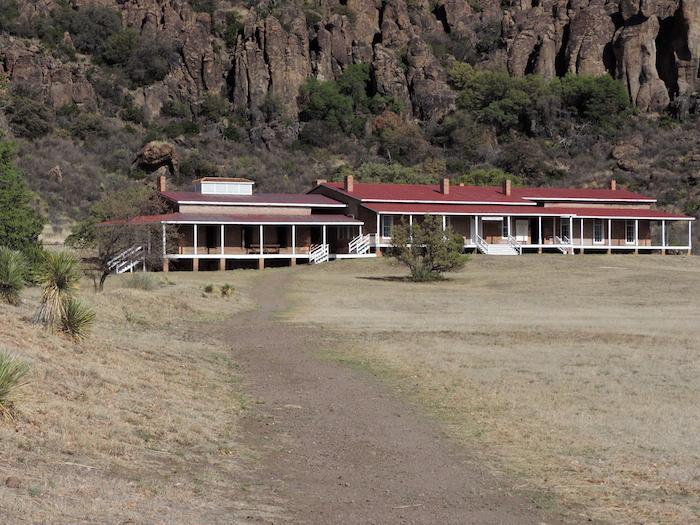
The post hospital was well stocked ... for the 19th century/Lee Dalton
Beyond Officer’s Row and higher on a rising hillside stands the post hospital. Exploring the historic park requires a lot of hiking, but that gave me plenty of time to think about the stories told on interpretive panels spotted along the trails. As anyone who has been a service member can attest, our military has always run on paperwork. It’s that pile of paper lying preserved somewhere that helps bring stories of Fort Davis to life for us today and make it much easier to understand what this place was all about.
Fort Davis had three chapters in its story. It was originally built as a primitive camp in 1854 to try to protect traffic along the San Antonio–El Paso Road. In 1861, after Texas seceded from the Union at the beginning of the Civil War, it was occupied by Confederate troops until the summer of 1862, when Union soldiers again took possession for just a short time before abandoning the post for five years. Few of the original buildings remained in 1867 when the Ninth U.S. Cavalry reoccupied the post. Soldiers and civilian contractors rebuilt the fort and then spent nearly 20 years adding more and more buildings to the fort. Finally, by the 1880s, the fort housed more than 100 structures and 400 soldiers. Many officers, and a few enlisted men, were joined by their wives and families. In fact, one of the bugle calls I heard was School Call, which would have called post children to school each day.
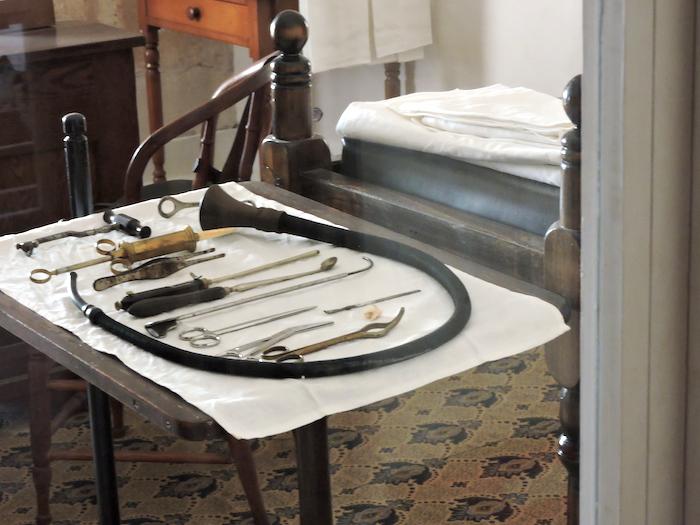
Fort Davis doctors were poorly equipped compared to today's standards/Lee Dalton
Fort Davis was abandoned by the Army in 1891. Some of its empty buildings were taken over by local people and used for a variety of purposes. This was a stroke of luck for us today because it prevented buildings from being completely ruined. When the place became a national historic site in 1961, the Park Service was able to restore many of the buildings, as opposed to having to reconstruct them.
The Park Service has done a great job of turning those piles of Army paper into stories that humanize Fort Davis. One of the most significant is the record of service here by African American soldiers – the Tenth Cavalry’s “Buffalo Soldiers.”
We learn how these troops were commanded by white officers, and we also learn the story of Second Lt. Henry O. Flipper. Flipper was the first African American to graduate from West Point. He was sent straightaway to Fort Davis, where he was assigned as commissary officer. As you can easily imagine, Lt. Flipper was not well regarded in those days by most white officers. He was soon charged with a number of trumped-up crimes involving improper record-keeping and theft of property from the commissary. A court-martial found him guilty of some of the charges, and he was summarily dismissed from the Army in 1882.
After leaving the army, he continued in life as a successful engineer. Then, in 1976, his case was reviewed and he received a posthumous honorable discharge. In 1999, he was granted a full presidential pardon.
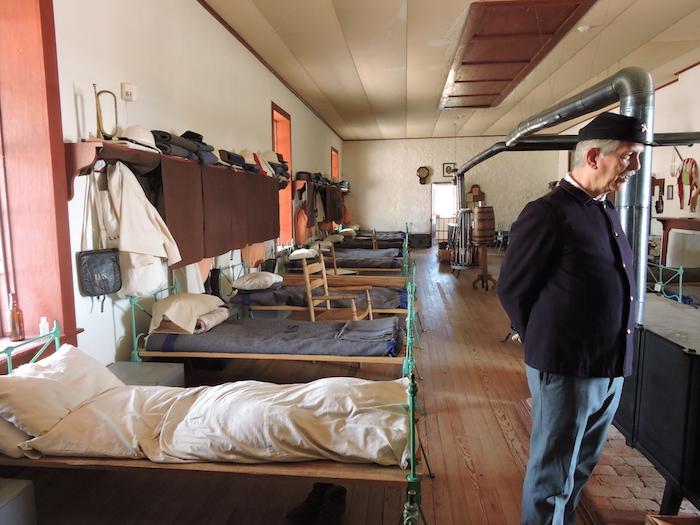
Volunteer Richard Martin will captivate you with stories of 19th century life at Fort Davis/Lee Dalton
Wandering into the restored enlisted barracks, I find volunteer Richard Martin waiting to tell stories of men who slept in bunks here. Again, thanks to Army records, he shares details of their lives that help bring the fort back to life. He tells of one soldier who somehow wound up in Alcatraz and another who fell ill with dysentery and slowly died in the post hospital. He tells of letters written, arguments over card games that put men in the guardhouse, and paints a fascinating portrait of lives of real Buffalo Soldiers.
Across the parade grounds, I roam through a couple of restored officers’ quarters where junior officers shared duplexes with other officers and families. I take a moment to look at a photo of post children gathered in front of one of the homes and imagine their playful laughter mixed with military noises. It’s a little surprising to find the fine array of furnishings that had been hauled to the fort by these people. Especially luxurious is the home of Col. Benjamin Grierson, who was the last commander of Fort Davis.
On beyond Officer’s Row, I come to the hospital. Only part of it has been restored and refurnished, but interpretive panels tell stories of people who lived and worked and even died within its walls. We can peer into the surgeon’s office at a table filled with what were once state-of-art surgical instruments. We read of treatments applied for various illnesses and injuries. Treatments that make us wince today. Such as: “September 10, 1888 – Hand surgery on Private Henry Daum. Contused and lacerated wound, second finger, left hand, severe. Struck with ball while playing baseball. Amputated the digital phalanx with antiseptic precautions. Anesthetic: Cocaine 4 percent sol mxv injected around seat of injury. – Post Surgeon John V. Lauderdale M.D.”
We can also read of 5-year-old Centennia America Williamson, who was the only child of the post hospital steward and his wife. She died of diphtheria on February 12, 1881. The panel outside the steward’s room tells us: “Diphtheria was one of the major killers of children in the pre-vaccine era and was known as the ‘strangling angel of children’ because of the way the infected throat membrane suffocated its victims.”
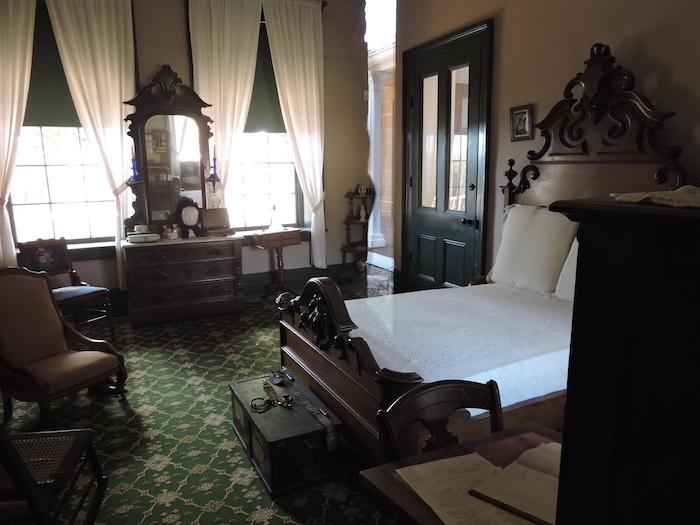
The post commander lived in relative comfort/Lee Dalton
As I leave the hospital and walk back across the parade ground, I meet a small herd of students from a high school in Midland, Texas. They’re laughing and talking and even looking at cell phones until they reach a panel with some stories of patients at the hospital – including some of the story of little Centennia. They pause, put down their cell phones, and read in silence. A few whispered words follow and then they walk away toward the hospital.
Once again I’m reminded of how places like Fort Davis, preserved for us by our Park Service, provide connections with our past, our present, and even our future. It’s one thing to read our nation’s tales in textbooks. But it’s another thing entirely to walk in the places where it actually happened. It’s hard not to be touched by the words and stories of people who actually lived the history we read today.
How I wish that students like these from schools everywhere could somehow be transported on visits to Fort Davis and the other places we’ve deemed worthy of preservation. I hope we value them enough to make sure they survive unimpaired for future generations.



Comments
Thanks, Lee. As a longtime soldier I find places like this fascinating.
Another wonderful article and photos from you, Lee. It's always interesting how old buildings can speak volumes of history. Thanks!